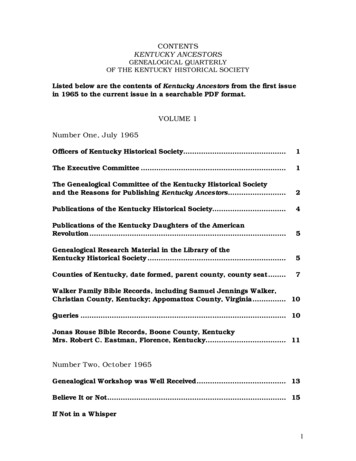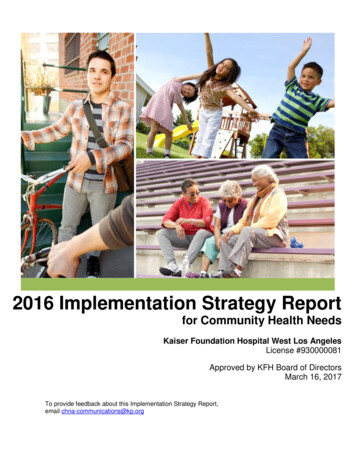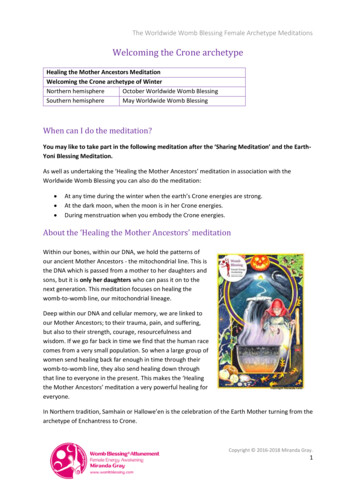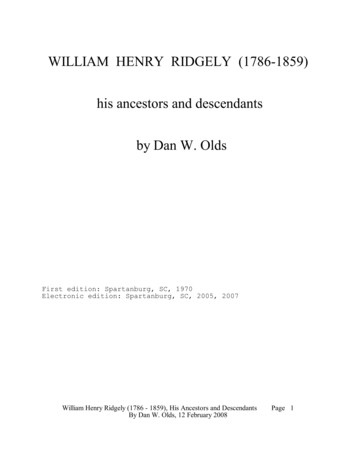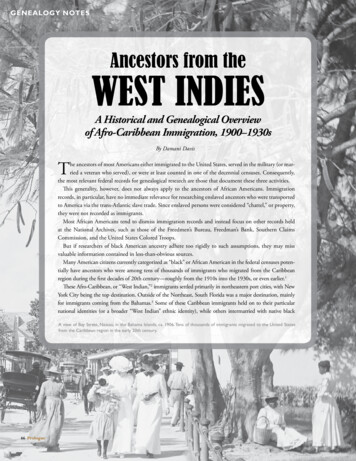
Transcription
GENEALOGY NOTESAncestors from theWEST INDIESA Historical and Genealogical Overviewof Afro-Caribbean Immigration, 1900–1930sBy Damani DavisThe ancestors of most Americans either immigrated to the United States, served in the military (or mar ried a veteran who served), or were at least counted in one of the decennial censuses. Consequently,the most relevant federal records for genealogical research are those that document these three activities.This generality, however, does not always apply to the ancestors of African Americans. Immigrationrecords, in particular, have no immediate relevance for researching enslaved ancestors who were transportedto America via the trans-Atlantic slave trade. Since enslaved persons were considered “chattel,” or property,they were not recorded as immigrants.Most African Americans tend to dismiss immigration records and instead focus on other records heldat the National Archives, such as those of the Freedmen’s Bureau, Freedman’s Bank, Southern ClaimsCommission, and the United States Colored Troops.But if researchers of black American ancestry adhere too rigidly to such assumptions, they may missvaluable information contained in less-than-obvious sources.Many American citizens currently categorized as “black” or African American in the federal censuses poten tially have ancestors who were among tens of thousands of immigrants who migrated from the Caribbeanregion during the first decades of 20th century—roughly from the 1910s into the 1930s, or even earlier.1These Afro-Caribbean, or “West Indian,”2 immigrants settled primarily in northeastern port cities, with NewYork City being the top destination. Outside of the Northeast, South Florida was a major destination, mainlyfor immigrants coming from the Bahamas.3 Some of these Caribbean immigrants held on to their particularnational identities (or a broader “West Indian” ethnic identity), while others intermarried with native blackA view of Bay Street, Nassau, in the Bahama Islands, ca. 1906. Tens of thousands of immigrants migrated to the United Statesfrom the Caribbean region in the early 20th century.66 Prologue
Americans. Either way, most of the descendants of this earlywave of Afro-Caribbean immigration are now officially cat egorized and regarded as black and/or African American.For black Americans with ancestors from the Carib bean region, the citizenship records held at the NationalArchives can serve as a valuable genealogical resource.The specific records—and the methods used to researchthese records—are generally standard for all immigrationresearch, regardless of nationality.4Slaves Came to U.S. MainlandBy Many Different RoutesHistorically, continuous streams of migration involving peopleof African descent have moved back and forth between NorthAmerica and the West Indies. Many of the earliest enslavedblacks in the American colonies were transported to the NorthAmerican colonies by way of the Caribbean.South Carolina, for instance, was essentially founded in thelate 1600s as a mainland extension of the British colony ofBarbados when slaveholding families moved to North Americato acquire land for new plantations. Those families initiallybrought their enslaved property with them and importedothers from the West Indies. Only later—when its rice andindigo plantations became more prosperous and required morelabor—did South Carolinians begin to import large numbers ofenslaved Africans directly from the continent.The eruption of the Haitian Revolution in 1791 sentanother wave of migration from the Caribbean region. Fromthe 1790s until approximately 1810, thousands of white, freecolored, and some enslaved black Haitian refugees relocatedto coastal cities such as Savannah, Charleston, Norfolk,Baltimore, Philadelphia, New York, and especially to NewOrleans, where they made their most significant cultural anddemographic impact.These Haitian émigrés influenced some of the uniquecharacter associated with New Orleans and southern Loui siana—including that region’s music, religious practices,cuisine, and other customs.Migration also moved in the opposite direction.British Loyalists, Their SlavesFlee during Revolutionary WarA mass migration of blacks from North America to the WestIndies occurred in the 1780s at the conclusion of the Ameri can Revolutionary War. The American “Tories,” or “Loyalists”who had sided with the British crown, evacuated with Britishforces from the ports of New York, Charleston, Savannah, andBritish East Florida.Among these evacuees were large numbers of “Black Loyal ists” who had escaped from slavery in the southern colonies andfought alongside the British in exchange for freedom. After thewar, these black Loyalists migrated to destinations throughoutthe British Empire, particularly to the British West Indies, NovaScotia, and Sierra Leone in West Africa.5Southern white Loyalists who were slaveholders were alsoallowed to evacuate with their “enslaved property.” Many ofthem relocated to the slave-based plantation societies in theBritish West Indies while others sold off their human propertythroughout that region. Of the various islands of the BritishWest Indies, the Bahamas and Jamaica received the largest totalnumber of blacks from the American colonies—whether free orenslaved.6 But of these islands, the sparsely populated Bahamas,by far, felt the most significant demographic and cultural effects.The population of the Bahamas tripled when thousandsof black and white Loyalists arrived from Charleston,Savannah, and British East Florida. The majority of theblack evacuees were natives of the Gullah or “Geechee”cultural regions of the coastal Carolinas and Georgia.Enos Gough arrived in New York City in July 1909 from Jamaica.The ship’s manifest lists his profession as a carpenter and his destination as Philadelphia.Ancestors from the West IndiesPrologue 67
Cyril Crichlow ofTrinidad became anaturalized U.S. citizenin 1919, but this ship’spassenger list records hisreturn from a visit to histhe island in 1929.Commenting on the cultural impact of this massmigration to the Bahamas, Bahamian writer and folkloristCordell Thompson states, “The new arrivals . . . broughttheir food, culture, folkways, and most importantlytheir language. Although a British colony from 1670 toindependence in 1973, culturally and linguistically, thecharacter and personality of the Bahamian people owemuch to the Gullah people who live in the coastal islandsoffshore of South Carolina and Georgia.”Ironically, the later 20th-century migrations ofBahamians to the United States, particularly their heavymigration to south Florida, can actually be viewed as atype of “return migration.”7Later Migrations DocumentedIn Federal Records HoldingsThe 20th-century migrations were a continuance of theseearlier waves of migration, but they were driven by thesearch for economic betterment rather than the slave tradeand revolutionary upheaval. The modern migrations aremore likely to be documented in federal records.The first significant wave of recent Caribbean immigration occurred during the first three decades of the 20th century, particularly during World War I and throughout the1920s. Before this time, Caribbean migration was primarilyinternal as migrants sought economic opportunities inother islands and nations throughout the Caribbean basin.The Panama Canal project, for instance, attracted over200,000 Afro-Caribbean immigrants from 1881 to 1914.But with the completion of the Panama Canal, along withsevere economic recession throughout the region, migrantsbegan to seek opportunities in North America. The passage ofthe highly restrictive Johnson-Reed Immigration Act of 1924,which sharply curtailed all immigration from non-WesternEuropean countries, put an end to this era of immigration.68 PrologueThe Johnson-Reed Act introduced the new “NationalOrigins Formulas,” a system of quotas based on the existingproportions of immigrant populations in the United States.The explicit purpose of the National Origins Formula was tolimit the immigration of various white ethnic groups comingfrom Southern and Eastern Europe and to restrict all “nonwhite” immigrants in general—particularly blacks and Asians.Since the proportion of Afro-Caribbean immigrantsby the 1920s made up only a tiny segment of the traditional body of American immigrants, continued immigration from that region into the United States was, byand large, terminated.New Wave of ImmigrationComes with World War IIA second, but much smaller, wave of immigration fromthe Caribbean occurred with the onset of World War IIand throughout the 1940s and 1950s.This new migration was spurred by American laborshortages during World War II along with expandingeconomic demands in the immediate postwar period.Many immigrants during this period worked as farmlaborers in Florida and other southeastern states and inConnecticut and other northeastern states. These laterarrivals were also affected by the passage of the McCarran-Walter Immigration and Nationality Act of 1952.Although the McCarran-Walter Act abolished racialrestrictions, it still determined the suitability of potentialimmigrants based on nationality and regional distinctions, with preference given to those from non-Communist countries and from northern and western Europe.The last, and latest, wave of Caribbean immigration wasgenerated by the larger changes in American policy thatresulted from the Civil Rights movement in 1960s. The HartCeller Immigration and Nationality Act of 1965 abolished theFall/Winter 2013
National Origins quotas and the explicit racial bias that hadlong prevailed in the nation’s earlier immigration policy.The removal of these barriers resulted in an unprecedentedrise in the number of “non-white” immigrants coming fromthe Caribbean, Latin America, Asia, and Africa. This waveexpanded in the 1970s and has continued into the currentcentury. This last wave, however, is too recent for practicablegenealogical research. Viable research of Caribbean heritageshould focus on the federal records produced during firstimmigration wave of the World War I era.A Declaration ofIntention for JonathanRolle, father ofactress Esther Rolle,dated April 30, 1928.After the declaration,the immigrant couldfile a formal petitionfor citizenship.Many Records AvailableAt the National ArchivesFederal immigration and naturalization records (RecordGroup 85) are the primary genealogical resource for thoseresearching immigrant ancestors at the National Archives.These records consist of the passenger arrival records ofimmigrants and the naturalization records of those wholater chose to become U.S. citizens. These records providevaluable personal information about each immigrant.The passenger lists, or ships’ manifests, generally listedeach passenger’s full name, age, sex, marital status, occupa tion, and nationality; the passenger’s last place of residencein the native country; the destination in America; whetherthe passenger had ever been in the United States before,and if so, when and where; and, whether the passenger wasgoing to join a relative already residing in the United States,and if so, that relative’s name, address, and relationship.These passenger arrival records are available on micro film at the National Archives in Washington, D.C., andat the regional facilities that hold the arrival recordspertaining to the ports in their area.Ship passenger arrival lists from the major east coast ports ofBoston, New York, and Baltimore cover a period ranging from,approximately, 1820 to 1982. A small, incomplete series forthe port of Philadelphia begins even earlier, in 1800. Passengerarrival lists for the Gulf Coast begin in 1846 for Galveston and1813 for New Orleans. Records for immigrants who arrivedearlier than these years may be found on the local level—ateither the port of entry or at a state archives.Researchers also should keep in mind that the port ofentry where the ancestor arrived may differ from the cityor state where he or she eventually settled. For instance,an ancestor who settled in New York may have actuallyentered the country at the port of Philadelphia, or viceversa. Also, a fair amount of Caribbean immigrantsentered through the Port of New Orleans, even thoughthey may have settled elsewhere.Ancestors from the West IndiesOnce the ancestor’s port of entry is identified, thegenealogist can search the microfilmed passenger listsat the National Archives in downtown Washington,D.C., or at any of our archival research rooms across theUnited States.8 Passenger lists have also been digitizedand are available on sites such as Ancestry.com and Fold3.Naturalization Records ProvideMuch Information on ImmigrationIf the immigrant ancestor later chose to become a U.S.citizen, the naturalization documents can provide addi tional genealogical information.Naturalizations taking place after 1906 recorded theapplicant’s name, place and date of birth, occupation,address, date of arrival in the United States, port of arrival,and the name of the vessel, along with the names of spouseand minor children with their dates and places of birth.The naturalization process typically required that the immi grant reside in the United States for at least five years. Aftertwo years, the immigrant could file a formal “declaration ofintent” to proclaim that he or she desired to become a citizen.This application required the immigrant’s name, age,country of birth, date of application, and sometimes,date and port of arrival into the United States. After thedeclaration, the immigrant would file a formal petitionfor citizenship, which typically contained the petitioner’scurrent residence, occupation, date and country of birth,and port and date of entry into the country.Federal courts first began to administer naturalization pro ceedings beginning in 1906, and the records are available fromthat year to 1995. Before 1906, state and local also had juris
diction over naturalization proceedings, and not all of thoserecords were necessarily transferred to the National Archives.The National Archives’ regional archives hold therecords of naturalizations performed in their regions.Contact the specific regional archives to get the detailson availability (a list of locations is inside the back coverof this magazine), but these records are also digitallyavailable on sites such as Ancestry and Fold3.9Other relevant federal records can supplement the datafound in the passenger lists and citizenship records. Census records (Record Group 29) contain information onthe households of individuals and families once they hadsettled in the United States. Passport application records(Record Group 59) can be informative, particularly forresearchers whose ancestors may have traveled back totheir native countries for visits during certain years.10Military records can be of value for those with ancestorswho enlisted or were drafted by the United States armedforces after they settled in the United States. Maritime andmerchant marine records can be useful for descendants ofthe many Caribbean natives who served as seamen.Research opportunites can continue outside the UnitedStates. Check records held locally in the West Indies—orin the archives of the European nation that formerly heldcolonial authority over the Caribbean nation (such as theNational Archives of the United Kingdom for nationsonce part of the British West Indies).There also are select federal records at the NationalArchives that relate to specific nations and may be of useto some researchers.Records documenting Caribbean ancestors who laboredin the Panama Canal Zone may be found in Records of thePanama Canal, 1851–1960 (Record Group 185). Thoseresearching ancestors from the Virgin Islands or the formerDanish West Indies nations of St. Thomas, St. Croix, and St.John, should check the Records of the Government of theVirgin Islands, 1672–1957 (Record Group 55).These Virgin Island records relate to both the Danish colonial administration up to 1917 and the subsequent Americanadministration up to 1957. Records from the earlier periodare written in Danish. The records covering the Americanperiod consist of reports from local newspapers and generaladministrative, legislative, police, and military functions.Local land records, however, remain in the Virgin Islands.The Stories of Two Immigrants:Cyril Crichlow of TrinidadTrinidad native Cyril Crichlow was born in Trinidad in70 PrologueCyril Crichlow’sWorld War I draftregistration cardrecords suchinformation as dateof birth, country oforigin, profession,and current address.1889, immigrated to the United States in 1905, and becamea naturalized citizen in 1919. On June 5, 1917—two yearsbefore becoming a naturalized citizen—Crichlow submittedhis mandatory World War I Draft Registration Card.The card listed him as a resident alien and citizen ofTrinidad, B.W.I. [British West Indies], residing at 5245Dearborn in Chicago, Illinois. He was employed as an“Editor” at Half Century Magazine on Wabash Avenue;he had a wife and children as dependents; and he claimedexemption from the draft on the grounds that he was analien and because of his religion.After becoming a naturalized citizen, Crichlow continued to visit his native country as shown by a 1929 shippassenger arrival record that documents him arriving atthe Port of New York on a return visit from Trinidad. Ona 1920 passport application, Crichlow gives a thoroughstatement that confirms the information provided on hisimmigration documents and World War I draft card:I, Cyril Askelon Crichlow, a Naturalized and LoyalCitizen of the United States, hereby apply to theDepartment of State, at Washington for a passport. . . I , solemnly swear that I was born at Trinidad,British West Indies on September 12, 1889; that Iemigrated to the United States, sailing from Port ofSpain, Trinidad about July 27, 1905; That I resided15 years, uninterruptedly, in the United States, from1905 to 1920 at College View, Nebraska, . . . Chicago,Ill., New York, NY (except from June 1918 to Feb.Fall/Winter 2013
1919 with the A.E.F. in France); that I was natu ralized as a citizen of the United States before theSupreme Court of New York . . . on April 1st, 1919. . . that I am domiciled in the United States, mypermanent residence being at 2376 7th Ave., NewYork . . . where I follow the occupation of PrincipalBusiness School & Shorthand Reporter; that I amabout to go abroad temporarily, and intend to returnto the United States within Four (4) years with thepurpose of residing and performing the duties ofcitizenship therein; and that I desire a passport foruse in visiting the countries hereinafter named forthe following purpose: Liberia, West Africa: Engag ing in teaching & reporting.The passport application lists his age as 31 and provideshis physical description along with a photograph. A signedstatement addressed to the Department of State notes, “Thiscertifies that the undersigned Applicant for passport to Libe ria, W.A. desires same in order to go there for the purpose ofestablishing a business school and engaging in the profession ofshorthand reporting.” Historical research on Cyril A. Crichlowindicates that he had been an active member of Marcus Gar vey’s United Negro Improvement Association (UNIA), and histrip to Liberia was on behalf of that movement.The last form of federal documentation on Crichlowappears in the 1930 census, which shows that he was living inWashington, D.C., was married to a native of New Jersey, andhad a 17-year-old son named Martin, who had been born inMississippi and was employed as an elevator operator.The census schedule lists Cyril as 40 years old in 1930;he had been 20 years old when he got married; he was aveteran of the U.S. armed forces; and he was currentlyemployed as a messenger for the U.S. Government. Hisplace of birth is listed as Trinidad, although his fatherand mother had been born on the island of Barbados.Cyril Crichlow’s active life, which involved not onlyhis initial immigration and naturalization as a U.S. citi zen but also his continued travel and his military service,produced several forms of federal documentation thatprovide detailed information about him.Not all Caribbean immigrants were as thoroughlydocumented. Caribbean immigrants who never pursuedU.S. citizenship would have no naturalization records.Not all of them served in the military or were requiredto register for the World War I draft, and others may nothave been able to return to their native lands or travel asfrequently as Crichlow. But if all you can find is the ini tial passenger arrival record, you will still have importantdetails such as the hometown in the native country andthe name of the closest relative still living there.The Stories of Two Immigrants:Enos Gough of JamaicaEnos Gough’s story is documented only in immigration,citizenship, and census records. A passenger manifestrecords his arrival in the Port of New York on July 7, 1909,from Port Antonio, Jamaica.Cyril Crichlow’sJanuary 1921passport applicationincludes a photo graph, his age,physical description,and statement ofintention to travel toLiberia, West Africa,where he intendedto work on behalf ofMarcus Garvey’s PanAfrican movement.Prologue 71
I, Enos Theophilus Gough, aged 31 years, occupa tion, Butler, do declare on oath that my personaldescription is: color, Black; complexion, dark;height 5 feet 11 inches; weight, 164 pounds. . . . I wasborn in Montego Bay, St. James, Jamaica BWI, onthe 19 day of January, [A.D.], 1881; I now reside at1928 Montrose St, Philadelphia, Pa. I emigrated tothe United States of America from Montego Bay,Jamaica BWI on the vessel Bradford: My last resi dence was St. Ann’s Bay, Jamaica, BWI . . . I arrivedat the port of New York . . . on or about the 17thday of June [A.D.] 1909.A petition fornaturalization canprovide useful familydata, including placeof residence; maritalstatus; name andbirthplace of wife; andnames, birthplaces, andand ages of children, asshown in this petitionof Enos Gough.After submitting the required “declaration of inten tion,” Gough submitted his formal “petition for natu ralization” several years later, in 1918. The informationprovided on that form reads:The ship’s manifest lists Gough as 27 years old, single,literate, and a carpenter by trade. His last place of per manent residence is identified as Montego Bay, Jamaica,and his final destination is listed as Philadelphia, Penn sylvania. The nearest relative or friend back in his nativecountry is Henry Gough of Anchovy, Jamaica. Sincethey share the same surname, there is a good chance thatthis person is an immediate relative.Enos Gough’s initial “declaration of intention” tobecome a naturalized citizen in 1912 reads:To learn more about How to find ancestors in the PanamaCanal Zone, 1904–1914, go /. The African American experience in the PanamaCanal, go to /. Immigrants arriving in the 1940s and 1950s, goto /a-files.pdf.72 PrologueMy place of residence is 2117 M[ton?] St, Phila. Pa.My occupation is Carpenter. I was born on the 19day of Jan. [A.D.] 1881, at Montego Bay, JamaicaBWI. I am married. My wife’s name is Isabella,2/18/89. She was born in Phila. and now resideswith me. . . . I have 3 children, and the name, dateand place of residence of each of said children asfollows:Henry, Sept. 13, 1912 in Boston, Mass.Clarence George, Feb. 23, 1916 Phila.Mabel, Aug. 16, 1917 Phila.Data from the 1920 and 1930 censuses provide moreinformation on Enos Gough’s household. In the 1920census, Gough, is listed as 38 years of age and a widow.This suggests that his wife Isabella had died sometimebetween 1918, when he submitted his petition fornaturalization, and 1920, when the census was taken.The 1920 census lists his occupation as a “Carpenter,Building Contractor” and confirms his year of immigra tion and naturalization as 1909 and 1918 respectively.The other members of the household are listed as hisAuthorDamani Davis is an archivist in the ResearchSupport Branch, Customer Services Division, atthe National Archives in Washington, D.C. Hehas lectured at local and regional conferences onAfrican American history and genealogy. Davis is agraduate of Coppin State College in Baltimore and received his M.A.in history at the Ohio State University in Columbus, Ohio.Fall/Winter 2013
children, Henry, age 7; Clarence, age 4; and Mabel,age 2. There is also a 42-year-old boarder namedMary E. Davis, who is a Virginia native and listed as“housekeeper, at home.”The 1930 census suggests that the widowed Goughand Davis had gotten married sometime during theintervening decade.11 The adults in the household arelisted as Enos Gough, aged 54, born in Jamaica, withan occupation listed as “carpenter at house.” His wifeis listed as Marie Gough, born in Virginia. The old est child, Henry, age 17, was attending school andemployed as a “presser” at a tailor shop. Clarence,age 13, was in school and employed as an “errandboy” at a drugstore. Mabel and Annabel, ages 12 and10 respectively, were also both in school and had nooutside occupations. during the early 20th-century. Actress Cicely Tyson’sfather, William Tyson, is documented arriving at thePort of New York from Nevis. Charles St. Hill, fatherof the politician and activist Shirley Chisolm, is docu mented as a 22-year-old native of Barbados—but thenliving in Guantanamo Bay, Cuba—who departed on theSS Munamar for the Port of New York.There are naturalization records of the parents ofactress Esther Rolle, who was the first of her parents’children to be born in the United States after they emi grated from the Bahamas to Broward County, Florida.Federal records document the family of Cynthia DeloresTucker, the late civil rights activist and leader of theNational Political Congress of Black Women, whose par ents immigrated to the United States from the Bahamasand resided in Richmond, Virginia, and New York Citybefore finally settling in Philadelphia.These federal records document an immigrantexperience that is not widely recognized, but it is anexperience that is a very important element of thelarger Afro-American history and culture in the UnitedStates. Many other examples can be used to illustrate thediverse experiences of individuals and families whoemigrated from the Caribbean to the United StatesNotes1This early 20th-century immigration of blacks from the Caribbeanregion coincided with the beginnings of the “Great Migration” of blackAmericans from the American South to cities in the North. Both migra tions, to some extent, were in response to new economic opportunitiesavailable in certain American cities resulting from a halt in immigrationfrom Europe as a result of the World War.2The term “West Indian” is a label used to designate inhabitantsor any other entity associated with the “West Indies” or the generalCaribbean region.In the context of American history and culture, the term has tradition ally been used to describe the English-speaking peoples of African descentwho emigrated from the Anglophone areas of that region, particularlypersons from nations formerly comprising the colonies of the “BritishWest Indies.” This term should cover all migrants from the former British,French, Danish, and Dutch nations in the West Indies. The Spanishspeaking Caribbean nations, however, have traditionally been viewed aspart of the greater Hispanic or Latin American cultural realm. In orderto include immigrants who may have been from certain FrancophoneCaribbean islands, such as Haiti, I use the broader term “Afro-Caribbean.”3The Schomburg Center for Research in black Culture has anexcellent website that describes various aspects of Black migration in thehistory of the United States (Afro-American, Caribbean, and African):www.inmotionaame.org.4Although this article focuses on Caribbean immigrants in general,with special emphasis on immigrants from the former British WestIndies, the records and research techniques can apply to all Afrodescended immigrants who came to the United States in the first halfof the 20th century, whether they were from the French-, Spanish-, orDanish-speaking Caribbean nations or were African immigrants fromCape Verde, from whence there was a significant stream of immigrationto the Boston area.Ancestors from the West Indies5A similar migration occurred after the War of 1812, when formerlyenslaved black Americans who escaped and joined the British forceswere allowed to settle on the island of Trinidad.6Historians estimate that approximately half of free and enslaved blackswho evacuated with the British ended up in the Bahamas and Jamaica;the rest were scattered throughout the British West Indies, Nova Scotia,and Europe. See Sylvia Frey, Water from the Rock: Black Resistance in aRevolutionary Age (Princeton, NJ: Princeton University Press, 1991); MayaJasanoff, Liberty’s Exiles: American Loyalists in the Revolutionary World (NewYork: Alfred A. Knopf, 2011); John W. Pulis, ed., Moving On: Black Loyal ists in the Afro-Atlantic World (New York: Garland Publishing, 1999); and,Benjamin Quarles, The Negro in the American Revolution, (Chapel Hill:University of North Carolina Press, 1961).7See Cordell Thompson’s blog at gullahgeecheeconnection.wordpress.com.8Reference Information Paper (RIP) 110, “Using Civilian Records forGenealogical Research in the National Archives Washington, DC, Area,”(National Archives & Records Administration, Washington, DC: 2009).9Ibid.10Passport records are held among the General Records of theDepartment of State (RG 59). Passport application records are avail able on microfilm at the National Archives. See Passport Applications,1795–1905 (National Archives Microfilm Publication M1372, 694rolls); Passport Applications, 1906 to March 31, 1925 (National ArchivesMicrofilm Publication M1490, 2,740 rolls); Registers and Indexesfor Passport Appli
Ancestors from the WEST INDIES - Archives . Damani Davis


